Voa亚裔美国人仍不受重视
美国种族问题概述

美国种族问题概述美国种族问题是全球范围内最为复杂和棘手的社会问题之一。
由于美国历史上的殖民主义和奴隶制度,种族歧视和不平等仍然存在于美国社会中,并对该国的政治,经济和文化局势产生了深刻影响。
本文旨在探讨美国的种族问题,以及政府和社会为解决这些问题所采取的措施。
一、美国种族问题的历史背景在美国历史上,对非裔美国人,原住民和其他少数族裔的歧视和压迫已持续了几个世纪。
自奴隶制度的建立以来,非裔美国人一直在经历着极端的不公正待遇。
直到1865年美国内战结束,奴隶制度才被废除。
尽管亚裔美国人和拉丁裔美国人并没有被奴隶制度直接影响,但他们也在强烈的歧视和不平等待遇下生活着。
在美国历史上,基督教白人和其他少数族裔之间的冲突和纷争也在不断加剧。
二、美国种族问题的现状尽管美国已废除奴隶制度,但种族不平等和歧视问题仍然存在。
当今美国,黑人占人口的13%,但在居住健康,教育和就业等方面仍然面临明显的不平等待遇。
例如,非裔美国人的失业率更高,收入更低,更容易受到暴力和犯罪的袭击。
在医疗卫生方面,黑人患有糖尿病,癌症,心血管疾病和艾滋病等疾病的比例也更高。
在教育领域,非裔学生的学业成绩明显低于其他族裔。
黑人和拉丁裔美国人的大学入学率和完成率也较低。
这在很大程度上源于底层贫困,家庭环境和他们所在学校的资源和质量等因素。
此外,亚裔美国人和劳工裔美国人也存在诸多种族问题。
在亚裔社区中,他们面临着有关名族转易,婚姻,留学和种族偏见等问题。
在拉丁裔社区中,包括非法移民,语言壁垒和贫困问题。
三、解决美国种族问题的政府和社会措施为了解决美国的种族问题,政府和社会采取了不少措施。
一些措施包括:1.联邦民权法1964年,国会通过了联邦民权法。
根据该法案,禁止以种族,性别和宗教为基础的歧视行为,这是美国历史上最具影响力的民权法案之一。
该法案限制了许多政府机构,包括在雇用,住房和教育方面,禁止在种族,性别和宗教方面进行歧视。
2.群体代表美国很多地方出现了代表性的群体,如“Black Lives Matter”,这是一种抗议行动,旨在侧重于稳定关注与黑人有关的问题。
2020年09月英语四级真题(第2套解析)
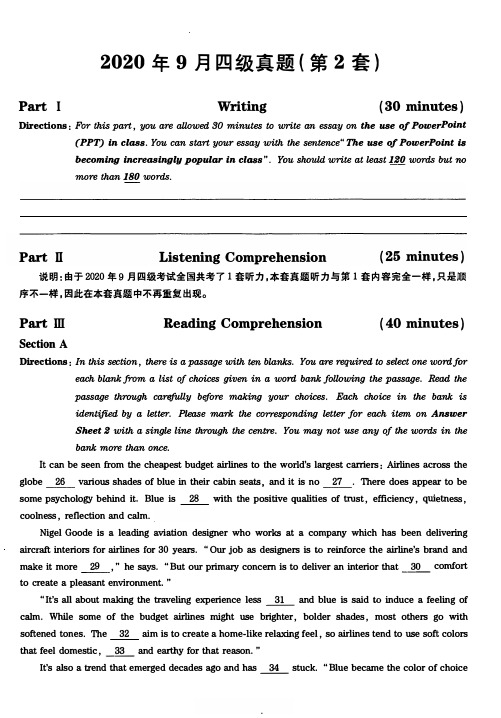
B) My excitement was short-lived. I remember heading to the library with my class and asking for help. I remember the librarian's hesitation. She finally led me past row after row of books, to a corner of the library where she pulled an oversized book off the shelf. She checked the index and turned over to a page about early Chinese immigrants in California. That was all there was in my entire school library in San Francisco, home of the nation's first Chinatown. That was it.
C)I finally had the opportunity to learn about Asian Americans like myself, and how we became part of the fabric of the United States when I took an introductory class on Asian-American history in college. The class was a revelation. I realized how much had been missing in my textbooks as I grew up. My identity had been shaped by years of never reading, seeing, hearing, or learning about people who had a sinlilar background as me. Why, I wondered, weren't the stories, histories, and contributions of Asian Americans taught in K-12 schools, especially in the elementary schools? Why are they still not taught?
亚裔歧视英文演讲稿范文
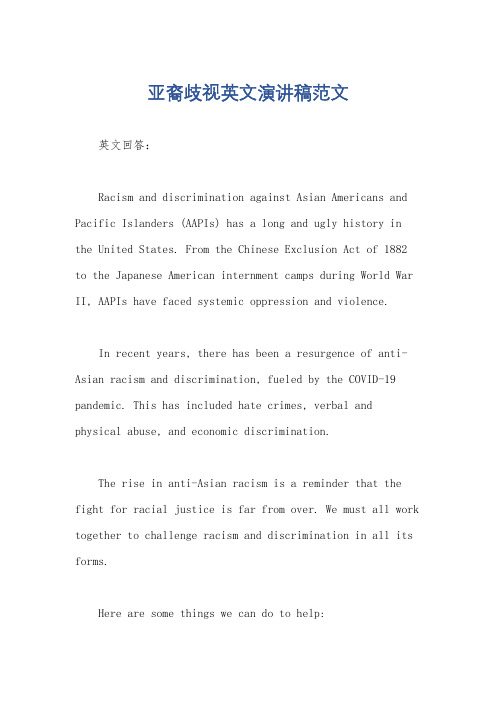
亚裔歧视英文演讲稿范文英文回答:Racism and discrimination against Asian Americans and Pacific Islanders (AAPIs) has a long and ugly history in the United States. From the Chinese Exclusion Act of 1882 to the Japanese American internment camps during World War II, AAPIs have faced systemic oppression and violence.In recent years, there has been a resurgence of anti-Asian racism and discrimination, fueled by the COVID-19 pandemic. This has included hate crimes, verbal and physical abuse, and economic discrimination.The rise in anti-Asian racism is a reminder that the fight for racial justice is far from over. We must all work together to challenge racism and discrimination in all its forms.Here are some things we can do to help:Speak out against racism and discrimination. Don't be afraid to call out racist and discriminatory behavior, even if it makes you uncomfortable.Support AAPI-owned businesses. Show your support for the AAPI community by shopping at their businesses and donating to their organizations.Educate yourself about the history of anti-Asian racism. The more we know about the past, the better equipped we will be to fight against it in the present.Be an ally to the AAPI community. Stand up for AAPIs who are facing racism and discrimination.Together, we can create a more just and equitable society for all.中文回答:亚裔美国人和太平洋岛民 (AAPI) 在美国的种族歧视和歧视历史悠久且丑陋。
美国白人歧视华人吗

美国白人歧视华人吗
近些年来,中国在经济、文化以及政治上的发展受到了全世界的瞩目。
中国文化一直受到世界其他文化的积极欢迎,但在这一过程中,华人受到种族歧视却是不可避免的事情。
在美国,白人对华人的歧视是一个不断存在的现象,不仅体现在就业及经济方面,也体现在日益严重的社会和文化层面。
一方面,在就业和社会经济方面,美国华人经常受到种族歧视。
即使他们拥有和本地白人同样的资历和资歉,仍然很难找到同样的工作和机会。
华人在学术上的成就更是受到怀疑,以质疑他们的能力和智力。
这种负面印象通常由社会环境传播,但是由于华人社区不够壮大,这种形象很难改变。
另一方面,美国华人也在文化及社会方面受到种族歧视。
在街头上,华人可能会被贴上汉奸和移民的标签,他们也难以在美国社会中找到自我认可。
此外,华人家庭经常受到邻居的歧视,从而限制他们参与社会活动,阻碍他们向社会融入。
然而,尽管受到歧视的情况还存在,美国华人也正在为改变这一局面而努力。
他们通过与当地社区建立友好关系,改变周围人对他们的看法,通过参与社区公益活动及政治活动,努力获得自己应有的尊重。
一些华人社团也在组织活动,以增进彼此的了解,促进彼此之间的互助。
有了这些努力,华人社区和美国其他社区之间的差距正在缩小,美国也在慢慢形成多元文化的社会。
在美国,华人实现真正的社会和文化融入的道路不会一帆风顺,
但是,他们一直在努力克服各种困难,实现自己的价值,以及为社会做出贡献。
华人应该继续追求自由、平等和尊重,以改善他们在美国华人社区的地位。
通过积极行动,华人可以消除白人歧视,为美国多元文化的和谐社会贡献出自己的力量。
美文赏析(八十九)Asian-Americans 亚裔美国人

美文赏析(八十九)Asian-AmericansIn only two decades Asian-Americans have become the fastest growing U.S. minority. As their children began moving up through the nations' schools, it became clear that a new class of academic achievers was emerging. Their achievements are reflected in the nation's best universities, where mathematics, science and engineering departments have taken on a decidedly Asian character. This special liking for mathematics and science is partly explained by the fact that Asian-American students who began their education abroad arrived in the U.S. with a solid grounding in mathematics but little or no knowledge of English. They are also influenced by the promise of a good job after college. Asians feel there will be less unfair treatment in areas like mathematics and science because they will be judged more objectively. And the return on the investment in education is more immediate in something like engineering than with an art degree.Most Asian-American students owe their success to the influence of parents who are determined that their children take full advantage of what the American educational system has to offer. An effective measure of parental attention is homework. Asian parents spend more time with their children than American parents do, and it helps. Many researchers also believe there is something in Asian Culture that breeds success, such ideals that stress family values and emphasize education.Both explanations for academic success worry Asian-Americans because of fears that they feed a typical racia limage. Many can remember when Chinese, Japanese and Filipino immigrants were the victims of social isolation.Indeed, it was not until 1952 that laws were laid down giving all Asian immigrants the right to citizenship.New words and expressions生词和短语minority [mai'nɔriti,mi-] n.少数,少数派;少数民族academic [ækə'demik] adj.学校的,学院的;学术的;纯理论的,不切实际的emerge [i'mə:dʒ] vi.(from)浮现,出现(问题等)发生,显露,(事实等)暴露breed [bri:d] n.种,品种vi.(bred [bred])繁殖vt.饲养,繁殖;养育,培育;酿成,产生typical ['tipikəl] adj.典型的,有代表性的racial ['reiʃəl] adj.人种的,种族的isolate ['aisəleit] vt.使隔离,使孤立参考译文亚裔美国人仅仅20年,亚洲人就成为美国发展壮大最快的少数民族。
美国黑人在社会生活中受到的种族歧视
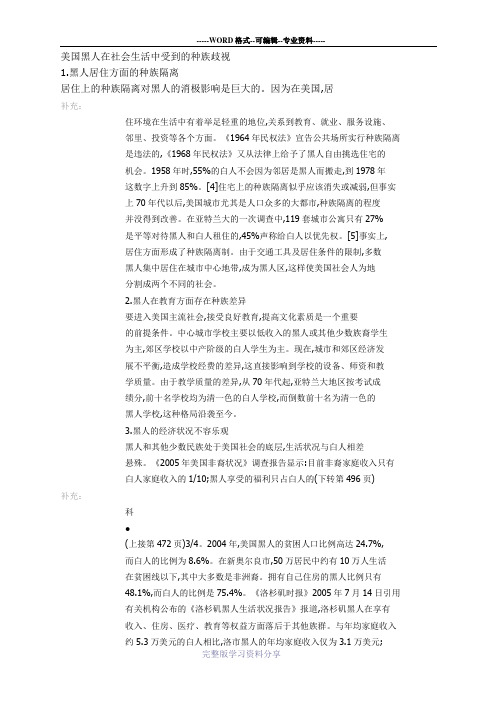
美国黑人在社会生活中受到的种族歧视1.黑人居住方面的种族隔离居住上的种族隔离对黑人的消极影响是巨大的。
因为在美国,居补充:住环境在生活中有着举足轻重的地位,关系到教育、就业、服务设施、邻里、投资等各个方面。
《1964年民权法》宣告公共场所实行种族隔离是违法的,《1968年民权法》又从法律上给予了黑人自由挑选住宅的机会。
1958年时,55%的白人不会因为邻居是黑人而搬走,到1978年这数字上升到85%。
[4]住宅上的种族隔离似乎应该消失或减弱,但事实上70年代以后,美国城市尤其是人口众多的大都市,种族隔离的程度并没得到改善。
在亚特兰大的一次调查中,119套城市公寓只有27%是平等对待黑人和白人租住的,45%声称给白人以优先权。
[5]事实上,居住方面形成了种族隔离制。
由于交通工具及居住条件的限制,多数黑人集中居住在城市中心地带,成为黑人区,这样使美国社会人为地分割成两个不同的社会。
2.黑人在教育方面存在种族差异要进入美国主流社会,接受良好教育,提高文化素质是一个重要的前提条件。
中心城市学校主要以低收入的黑人或其他少数族裔学生为主,郊区学校以中产阶级的白人学生为主。
现在,城市和郊区经济发展不平衡,造成学校经费的差异,这直接影响到学校的设备、师资和教学质量。
由于教学质量的差异,从70年代起,亚特兰大地区按考试成绩分,前十名学校均为清一色的白人学校,而倒数前十名为清一色的黑人学校,这种格局沿袭至今。
3.黑人的经济状况不容乐观黑人和其他少数民族处于美国社会的底层,生活状况与白人相差悬殊。
《2005年美国非裔状况》调查报告显示:目前非裔家庭收入只有白人家庭收入的1/10;黑人享受的福利只占白人的(下转第496页)补充:科●(上接第472页)3/4。
2004年,美国黑人的贫困人口比例高达24.7%,而白人的比例为8.6%。
在新奥尔良市,50万居民中约有10万人生活在贫困线以下,其中大多数是非洲裔。
拥有自己住房的黑人比例只有48.1%,而白人的比例是75.4%。
双语:针对亚裔美国人的隐形歧视
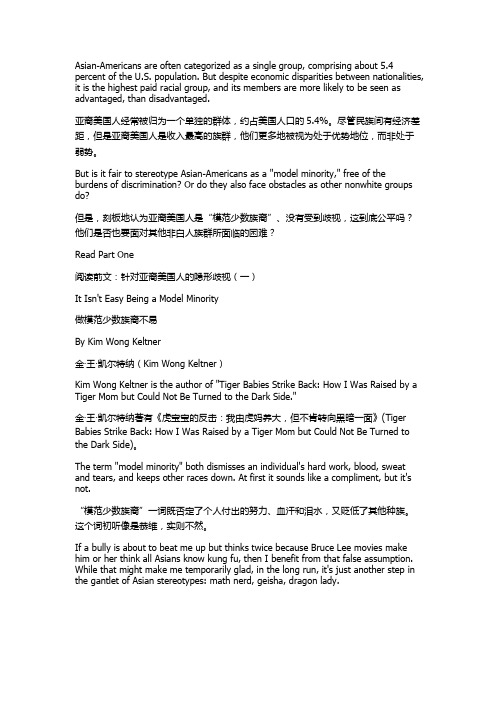
Asian-Americans are often categorized as a single group, comprising about 5.4 percent of the U.S. population. But despite economic disparities between nationalities, it is the highest paid racial group, and its members are more likely to be seen as advantaged, than disadvantaged.亚裔美国人经常被归为一个单独的群体,约占美国人口的5.4%。
尽管民族间有经济差距,但是亚裔美国人是收入最高的族群,他们更多地被视为处于优势地位,而非处于弱势。
But is it fair to stereotype Asian-Americans as a "model minority," free of the burdens of discrimination? Or do they also face obstacles as other nonwhite groups do?但是,刻板地认为亚裔美国人是“模范少数族裔”、没有受到歧视,这到底公平吗?他们是否也要面对其他非白人族群所面临的困难?Read Part One阅读前文:针对亚裔美国人的隐形歧视(一)It Isn't Easy Being a Model Minority做模范少数族裔不易By Kim Wong Keltner金·王·凯尔特纳(Kim Wong Keltner)Kim Wong Keltner is the author of "Tiger Babies Strike Back: How I Was Raised by a Tiger Mom but Could Not Be Turned to the Dark Side."金·王·凯尔特纳著有《虎宝宝的反击:我由虎妈养大,但不肯转向黑暗一面》(Tiger Babies Strike Back: How I Was Raised by a Tiger Mom but Could Not Be Turned to the Dark Side)。
“一个巨大盲点”:纽约亚裔为何感觉被忽视

“一个巨大盲点”:纽约亚裔为何感觉被忽视本月早些时候,当市长白思豪(Bill de Blasio)提出改变该市顶尖公立高中的入学方式时,他身边围绕着数十名热情的学生、工会领袖和民选官员,以及“所有孩子机会均等”的标语。
引人注目的是,一个深受该变化影响的群体却没有代表在场——亚裔美国人,他们的子女在这些学校占据多数。
“‘不是坐在餐桌边,就是在菜单上’,这种陈词滥调听上去还真是那么回事,”来自皇后区的国会众议员孟昭文说。
她毕业于其中一所知名学校史岱文森高中(Stuyvesant High School),那次活动没有邀请她参加。
“我想在其他社区,若是有如此大的影响或者这么大的变化,他们不会不被征求意见或者获邀参与讨论的。
”亚裔美国人社区的领袖们表示,在纽约,他们完全不是“模范少数族裔”——许多人认为这个词是一种贬损,而且也不准确——他们是被忽视的少数族裔,在纽约城的政治算计中不被当回事。
亚裔公职人员和活动人士称,在纽约市、州和联邦层面的全部五位亚裔当选官员跟白思豪和州长安德鲁·科莫(Andrew Cuomo)一样都是民主党人这一点,似乎于事无补。
不同背景的亚裔美国人,包括东亚和南亚人,现在占纽约人口的15%,自2000年以来,这个数字增加了一半,也没关系。
同样没关系的是,纽约市立大学研究生中心(CUNY Graduate Center)的城市研究中心(Center for Urban Research)有数据显示,华裔和韩裔的注册选民数量同期翻了一番。
“不止一件事,也不止这一次,”代表唐人街和下曼哈顿的民主党州众议员牛毓琳说。
“显示出整个亚裔美国社区的一个巨大盲点。
”但白思豪提出的解决特殊高中种族不均这一棘手问题的建议,激起了亚裔的强烈反应。
八所学校只有一个入学考试,学生中的亚裔人数比例格外之高,非裔和西语裔学生则太少。
白思豪建议取消考试,根据他们的班级和州考试成绩录取学生,这将带来非裔和西语裔学生数量的显著增加。
美国的亚裔歧视

美国的亚裔歧视总是有人,特别是亚裔会问我,为什么在美国亚裔面临如此大的敌意,总是被欺负而且不受尊敬?虽然我曾经就这类问题撰写过一本书,但是这也不是我的专业所在。
不过就这类问题,我愿意提供一个答案来供人们进行讨论。
亚裔容易遭到歧视有三个方面的原因,一是被视为是永久的外国人,不被接纳;二是所谓的“模范少数族裔”神话;三是美国的种族结构被限制在一种非黑即白的框架里。
首先,有关亚裔被视为永久的外国人。
实际上,亚裔来到美国大陆的历史已经很久远,但是却几乎没有人承认。
我们被排斥在历史课本之外。
但是,在美国南北战争时期,两边都有亚裔士兵。
19世纪中期,华裔和爱尔兰人一起来到美国,但是前者却被视为是短暂的“居留者”。
亚裔对建造横贯美国大陆的铁路做出了很大的贡献,甚至一些亚裔的家庭可以追溯到五月花号(the Mayflower)。
但是从排外时代以来,当公开的带有种族歧视倾向法律((1882年的《排华法案》))通过之后,亚裔被形容为是一股侵犯的力量,这种看法显然带有很深的敌意。
有关亚裔美国人不是“真正”的美国人的假设一直存在,就连有些宣称自己是反种族主义的人也抱着一样的看法。
虽然他们认为种族主义不可取,但是却认可本土主义。
他们坚信这其中有所差别,可以这么说,这种种族歧视被爱国主义华丽的外衣所掩盖了。
在这些人看来,对亚裔美国人的歧视不是有关种族,而是有关公民身份。
在美国,没有公民身份的亚洲人和亚裔美国人通常被混为一谈,只是因为我们“看起来一样”。
第二,亚裔身上还笼罩着一层所谓的“模范少数族裔”的光环。
这种迷思认为,亚裔总是能够取得“超出预期的成功”。
而且他们的平均收入要高于其他人,甚至包括白人。
这种看法从很多方面来看都站不住脚。
不过这种假意的奉承最糟糕的是因为其产生的种族仇恨,会让人们认为亚裔占据了超过自身能力的过多的资源。
第三,在美国,种族结构似乎被限制在一种非黑即白的框架里。
人们都能接受历史上著名的黑人民权运动(Black Civil Rights Movement),但是在涉及到其他有色人种的时候似乎就不再如此。
美国亚裔歧视英文作文
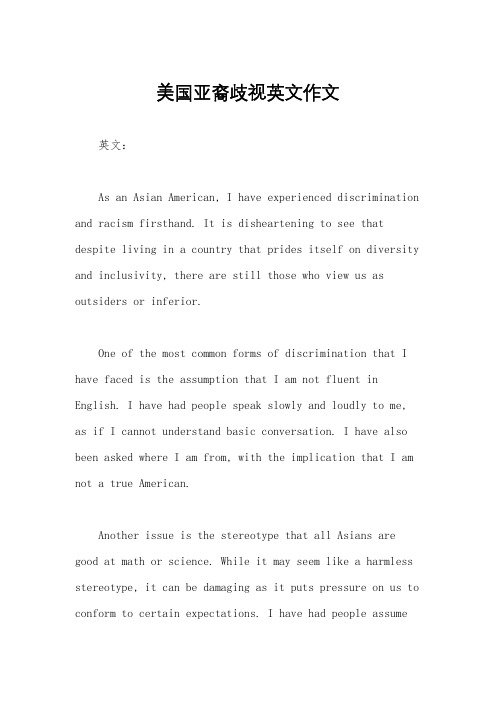
美国亚裔歧视英文作文英文:As an Asian American, I have experienced discrimination and racism firsthand. It is disheartening to see that despite living in a country that prides itself on diversity and inclusivity, there are still those who view us as outsiders or inferior.One of the most common forms of discrimination that I have faced is the assumption that I am not fluent in English. I have had people speak slowly and loudly to me, as if I cannot understand basic conversation. I have also been asked where I am from, with the implication that I am not a true American.Another issue is the stereotype that all Asians are good at math or science. While it may seem like a harmless stereotype, it can be damaging as it puts pressure on us to conform to certain expectations. I have had people assumethat I am a math genius simply because of my ethnicity, and it can be frustrating to feel like my abilities are being reduced to a stereotype.There is also the issue of fetishization, particularly towards Asian women. I have had men approach me and make inappropriate comments about my appearance or culture, as if I am a novelty to be fetishized rather than a person with thoughts and feelings.It is important to acknowledge that these experiences are not unique to me, and that many Asian Americans face similar forms of discrimination. It is crucial for society to address and challenge these prejudices, and for individuals to educate themselves and actively work towards being anti-racist.中文:作为一名亚裔美国人,我亲身经历过歧视和种族主义。
西方媒体对华人的负面报道
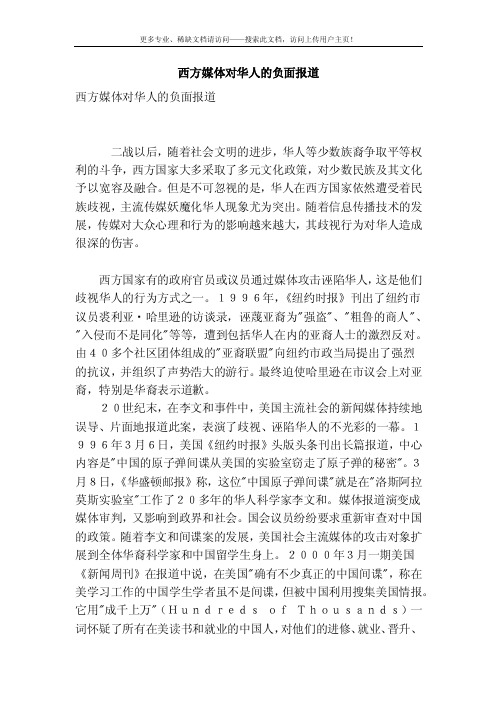
西方媒体对华人的负面报道西方媒体对华人的负面报道二战以后,随着社会文明的进步,华人等少数族裔争取平等权利的斗争,西方国家大多采取了多元文化政策,对少数民族及其文化予以宽容及融合。
但是不可忽视的是,华人在西方国家依然遭受着民族歧视,主流传媒妖魔化华人现象尤为突出。
随着信息传播技术的发展,传媒对大众心理和行为的影响越来越大,其歧视行为对华人造成很深的伤害。
西方国家有的政府官员或议员通过媒体攻击诬陷华人,这是他们歧视华人的行为方式之一。
1996年,《纽约时报》刊出了纽约市议员裘利亚・哈里逊的访谈录,诬蔑亚裔为"强盗"、"粗鲁的商人"、"入侵而不是同化"等等,遭到包括华人在内的亚裔人士的激烈反对。
由40多个社区团体组成的"亚裔联盟"向纽约市政当局提出了强烈的抗议,并组织了声势浩大的游行。
最终迫使哈里逊在市议会上对亚裔,特别是华裔表示道歉。
20世纪末,在李文和事件中,美国主流社会的新闻媒体持续地误导、片面地报道此案,表演了歧视、诬陷华人的不光彩的一幕。
1996年3月6日,美国《纽约时报》头版头条刊出长篇报道,中心内容是"中国的原子弹间谍从美国的实验室窃走了原子弹的秘密"。
3月8日,《华盛顿邮报》称,这位"中国原子弹间谍"就是在"洛斯阿拉莫斯实验室"工作了20多年的华人科学家李文和。
媒体报道演变成媒体审判,又影响到政界和社会。
国会议员纷纷要求重新审查对中国的政策。
随着李文和间谍案的发展,美国社会主流媒体的攻击对象扩展到全体华裔科学家和中国留学生身上。
2000年3月一期美国《新闻周刊》在报道中说,在美国"确有不少真正的中国间谍",称在美学习工作的中国学生学者虽不是间谍,但被中国利用搜集美国情报。
它用"成千上万"(HundredsofThousands)一词怀疑了所有在美读书和就业的中国人,对他们的进修、就业、晋升、居留产生广泛的负面影响。
在美国亚裔真的不如黑人吗

在美国亚裔真的不如黑人吗有人说,美国存在一种鄙视链,那就是:亚裔不如黑人,黑人不如白人。
这是真的吗?下面就来为大家解读在美国亚裔真的不如黑人吗?1、babyquant一个族裔在美国的地位,更多是这个族裔的精英决定的,不是这个族裔的整体平均收入决定的。
这句话接受了再往下读,否则无法交流。
美国的黑人,有逆天的奥巴马当总统,托马斯当最高法院大法官,乔丹、科比篮球巨星,无数歌星、影星,参议院、众议院也不少,这些人奠定了黑人在美国的地位。
大学录取也一样,学校更看重20、30年后这个校友能为学校带来什么,而不是过去3年你考试得了多少分。
一万个在硅谷捣鼓网页、数据库的码农,对社会的影响力,对学校声望的提升,也远不如出了一个奥巴马。
你可以鄙视奥巴马成绩差,鄙视他政策不好,鄙视他忽悠上位,抱怨他加税,抱怨他养穷人,抱怨他带来非法移民,但你也得接受这么一个事实——他当了美国总统,而全部亚裔没有一个人做到。
我从来没有看到哈佛说“啊,我们出了一个黑人总统,他让我们国家的债务增加了10几万亿美元;啊,我们看错了人;啊,我们培养了一个不好的学生。
”从来没有!哈佛从来都以培养了第一位黑人总统为荣!所以亚裔让哈佛放弃招收黑人,取而代之的是一群平庸的潜在的码农,可能吗?华人提高在美国地位的方法并不是状告哈佛,这其实很搞笑,犹太人录取率这么高是状告哈佛得来的?华人应该积极从政,竞选众议院、参议院、部长、总统、大法官,不管他是共和党还是民主党,不管他支持AA还是反对AA,这些都不重要。
重要的是他/她是华人。
不要动不动说哪个华人议员是汉奸,这是窝里斗,很幼稚,你自己又当不了议员,人家当上了又去拆台。
当然,你可以接受,可以不接受,反正华左融入白左,华右融入白右,华人就融入美国了。
2、复出东门采药去问这个问题之前我也想问一个问题:为什么从来没有人问过“在美国,华人的地位有印第安人高吗”?之所以会问黑人,是因为大家都看到了黑人当中确实有一小部分在美国风生水起。
白人为什么很少歧视亚裔

白人为什么很少歧视亚裔
亚裔在美国社会中越来越受到认可,白人很少歧视亚裔。
这是由多种因素造成的,包括社会环境的变化、法律法规的发展、白人的明智选择、社会对亚裔的理解以及亚裔文化的兴起等等。
首先,由于社会确实发生了变化,大多数人认识到歧视是错误的,他们不愿再歧视任何群体。
其次,受到政府的保护,多年来,美国法律法规取得了很大进步,以保护少数群体以及种族互动性不同群体不受歧视。
有了政府依法对付歧视行为的措施,白人也减少了歧视亚裔群体的行为。
第三,白人更加明智,他们明白歧视亚裔群体只会损害他们自己,即使也可以暂时获得小小的利益,但未来长远的影响将不利于白人主流社会。
第四,社会对亚裔的认可程度也不断提高,亚裔的文化也得到了外界的尊重和重视。
最后,社会上亚洲文化的兴起,也起到了歧视减少的作用,当亚裔移民的第二代可以更加有力地表达自我,展示他们自身的文化气息和魅力,这也有助于白人愿意接受亚洲文化。
在这种情况下,白人歧视亚裔的行为也变得不再可行.
总的来说,白人的态度对亚裔的歧视也发生了改变,他们也更愿意去接受和接纳来自不同群体的人。
因此,现在白人很少歧视亚裔。
亚特兰大枪击案后,美国亚裔政策何去何从

3月16日,在一个小时之内,亚特兰大地区的3家按摩院发生一连串枪击案,总共8人被枪杀。
8名遇害者中,有6名是亚裔女性。
凶手是一名21岁的男性白人。
16:50左右,警察接到报警,得知一家距离亚特兰大市北部约30英里的“杨氏亚洲按摩”(Young ’s Asian Massage )发生了枪击案,两名亚裔女性、一名白人女性和一名白人男性死亡,另外还有一名拉丁裔男性受伤。
案件发生后不到一小时,警方再度接到报警,赶到距离第一案发地点南27英里处的另外一家美容院,在那里发现了3具女性尸体,均为枪击遇害。
大约几分钟后,警方第三次接到报警,称一个水疗中心有人开枪,他们在现场发现了另一具女性尸体。
当天20点左右,警察逮捕了嫌疑犯,是一名叫罗伯特·朗(Robert Aaron Long )的21岁白人男子。
嫌疑犯被逮捕时正打算去佛罗里达州继续作案。
“站起来,反击!”案发第二天,亚特兰大警方召开新闻发布会,负责案件调查的警长认为嫌疑犯的动机是他“性成瘾”造成的。
嫌疑犯之前常光顾这些按摩院,在他看来这是一种诱惑,也因此起了摧毁这些按摩院的念头。
根据警方当时对外发布的信息,该枪击事件不是对亚裔的仇恨,射击不是因为种族歧视导致的。
警方甚至还说嫌疑犯那天心情不好,厚颜无耻地替这种恶行开脱。
警方的回应立刻引起公愤。
随后,警方不再对嫌疑犯的动机作任何解释或解读。
亚裔维权组织表示,不论案件是否与“仇亚”有关,亚裔美国人社区当下“充满恐惧和痛楚”。
案件引起所有亚裔社区的恐慌,亚特兰大枪击案标志着全美亚裔仇恨案件飙升到了前所未有的程度。
亚特兰大枪击案引发了政治抨击:美国联邦政府、大多数联邦议员、公众、媒体、专家学者都一致强烈指责美国前总统特朗普应该承担相当程度的责任,认为特朗普的言辞燃起了针对亚裔的仇外心理。
公众一致认为,这次犯罪是指向公民权利的侵犯。
亚特兰大针对亚裔的枪击案震惊全美,给美国社会,尤其是亚裔社会一个强烈的警示。
“模范”标签成亚裔晋升阻碍

“模范”标签成亚裔晋升阻碍作者:暂无来源:《环境与生活》 2016年第7期“模范”标签成亚裔晋升阻碍较高的平均收入和受教育程度,让美籍亚裔被贴上“模范少数族裔”的标签,他们工作努力、积极主动、富有责任感,他们的成功也证明了美国人才制度的行之有效。
听起来还不错,但这实际上给他们的学习和工作带来了很多麻烦。
美国威斯康星大学教授斯泰西·李的研究表示,这种形象让很多亚裔高中生在学校遇到困难时不好意思寻求帮助,往往使学习受阻。
美国佐治亚州立大学社会学家罗萨琳德·周发现,模范少数族裔的形象,让很多亚裔在遇到种族偏见的时候往往选择忍气吞声。
美国南加利福尼亚大学的一份研究显示,白人往往认为亚裔很被动、不够强势,根本不适合最高管理层的工作。
这种偏见成了亚裔晋升的阻碍。
而针对亚裔的偏见往往不被重视,美国圣里奥大学社会学副教授艾琳恩·奥布莱恩指出,跟非裔长期以来的积极争取不一样的是,亚裔没有多少社会和文化资源来对抗这种偏见。
臭氧太多让蜜蜂授粉觅食难花香中的化学物质是植物与蜜蜂等传粉昆虫的“通信”信号,传递了花的种类、受粉状态等信息,并帮助昆虫确定花的位置。
如果花香成分改变,其传递的信息也可能改变。
美国宾夕法尼亚大学研究人员的报告发现,空气污染会“降解”植物的气味,导致传粉昆虫的觅食时间被延长。
蜜蜂或其他访花昆虫能到离巢穴较远的地方采花粉和花蜜,是因为气流能把植物的气味分子传送到很远的地方。
研究人员发现,臭氧等空气污染源会改变植物气味的化学性质,使气味分子传播距离变短。
这么一来,访花昆虫就不能像往常那样轻松地找到可以授粉的花朵,得花更多时间去定位。
研究人员经过模拟发现,即便是在污染程度相对适度的空气环境下,昆虫寻找授粉目标也变得更加困难,这对它们的觅食习惯和食物供应会产生巨大影响。
西澳原住民自杀率高7倍位于西澳大利亚州北部的金伯利地区,是澳洲原住民的大本营。
2005 ~ 2014年间,金伯利有125起自杀,其中102人为原住民。
美国讨厌黑人还是华人

美国讨厌黑人还是华人
美国的白人讨厌黑人,黑人讨厌黄种人。
在美国的某些地区,黑人和亚裔之间的种族紧张关系较为普遍,但这主要是由于文化差异,事实上,东南亚和南亚人的肤色与黑人非常相似。
并非所有黑人都是针对亚洲人的种族主义者,这取决于他们对亚洲人的看法,取决于他们的无知和成见程度。
华裔的特点低调,而且内敛,喜欢忍气吞声,默默勤劳干事,不喜欢参与政治,不喜欢高调。
而美国的文化中,移民文化突出,其中最核心的就是要讲政治,而且必须高调,会哭的孩子有奶喝,会闹事的族群有地位,所以这两种文化其实是相悖的。
而黑人虽然比华裔要弱很多,但是黑人喜欢闹事,而且往往那是巨大的闹事,打砸抢烧,席卷全国。
好莱坞亚裔英文作文

好莱坞亚裔英文作文下载温馨提示:该文档是我店铺精心编制而成,希望大家下载以后,能够帮助大家解决实际的问题。
文档下载后可定制随意修改,请根据实际需要进行相应的调整和使用,谢谢!并且,本店铺为大家提供各种各样类型的实用资料,如教育随笔、日记赏析、句子摘抄、古诗大全、经典美文、话题作文、工作总结、词语解析、文案摘录、其他资料等等,如想了解不同资料格式和写法,敬请关注!Download tips: This document is carefully compiled by theeditor. I hope that after you download them,they can help yousolve practical problems. The document can be customized andmodified after downloading,please adjust and use it according toactual needs, thank you!In addition, our shop provides you with various types ofpractical materials,such as educational essays, diaryappreciation,sentence excerpts,ancient poems,classic articles,topic composition,work summary,word parsing,copyexcerpts,other materials and so on,want to know different data formats andwriting methods,please pay attention!Asians have been making a significant impact in Hollywood in recent years. From actors to directors,writers to producers, the presence of Asians in the entertainment industry is becoming more and more prominent.The success of movies like "Crazy Rich Asians" and "The Farewell" has proven that there is a demand for diverse stories and representation in Hollywood. These films have not only achieved commercial success, but also critical acclaim, showing that audiences are eager to see more authentic and nuanced portrayals of Asian characters and experiences on screen.However, the road to success for Asian talents in Hollywood has not been without its challenges. Many actors and filmmakers have spoken out about the lack of opportunities and the typecasting they face in the industry. Despite this, they continue to push boundaries and break stereotypes, paving the way for future generations of Asianartists.In recent years, there has been a push for more diversity and inclusion in Hollywood, and this has opened up new opportunities for Asian talents. With the rise of streaming platforms and independent production companies, there are more avenues for Asian filmmakers to tell their stories and showcase their talents without having to conform to traditional Hollywood standards.The success of Asian talents in Hollywood is not only a win for the individuals themselves, but also for the larger Asian community. It challenges stereotypes, breaks down barriers, and paves the way for a more inclusive and representative entertainment industry. As the influence of Asian talents continues to grow, we can expect to see even more diverse and compelling stories being told on the big screen.。
- 1、下载文档前请自行甄别文档内容的完整性,平台不提供额外的编辑、内容补充、找答案等附加服务。
- 2、"仅部分预览"的文档,不可在线预览部分如存在完整性等问题,可反馈申请退款(可完整预览的文档不适用该条件!)。
- 3、如文档侵犯您的权益,请联系客服反馈,我们会尽快为您处理(人工客服工作时间:9:00-18:30)。
亚裔美国人仍不受重视
Clicking through the channels, you might not see many Asians reporting on the evening news, even though they're the fastest growing segment of the U.S. population.
Juju Chang is one of only a handful of Asian-American news anchors, and she says it's due to a lack of diversity in top management.
“When I went on air at the network here, I was the only Asian-American and among the few women, and I'm sad to say that many all these many years later, I think that we've gone a long way in terms of diversity in front of the camera,
but I think we still have ways to go behind the scenes, especially in upper management.”
Chang says it's important for minorities to be involved when story ideas are approved.
“Until Asian-Americans get real traction in that sense, you know, we're going to keep pressing our noses against the invisible window.”
Asians make up only three percent of the broadcast workforce.
Journalism Professor Angie Chuang says a cultural bias may be to blame.
“The truth is that all kinds of psychological studies and employment studies have shown that we tend to favor or be more comfortable with people who are like us.”
Another issue is gender bias.
Television journalist Alan Wang spoke to us on Skype.
“I think the image of Asian women for other people is that they're soft, they're beautiful, they're not threatening, whereas the image of the Asian male, what you're looking at, really has been, you know, (this is) the face of the enemy of this country during the last three major conflicts.”
Analysts say Asians lack the political clout of other groups such as African-Americans and Hispanics.
Another group fighting for greater representation is the Asian American Journalists Association.
VOA spoke with the group's Vice-President for Broadcast Niala Boodhoo on Skype.
“Certainly, I feel like even having those conversations is something that would not have happened years ago, and I think the fact that we're even having those conversations is a sign of progress.”
A leading broadcast industry group says 2011 was the best year for Asian American broadcasters.
But still Asians made up only 3.5 percent of the industry.
And the percentage of Asians sitting behind this desk has declined since then.
And, with that, many Asians fear issues important to their communities will continue to be ignored.
尽管是美国人口中增长最快的群体,但在各电视台间浏览时,你可能仍不会在晚间新闻播报中看到很多亚裔女主播的身影。
长久久是为数不多的一位亚裔美国籍新闻主播,她表示这是因为最高管理层缺少多样性所致。
“当我做主播时,我是少数女主播中唯一的一位亚裔美国人,而且我要很遗憾的说,在这么多年之后,我想我们在荧幕前的多样化方面走了很长一段路。
但我仍觉得在幕后我们还有很长一段路要走,尤其是高层管理方面。
”
长久久表示在故事点子得到批准时,少数人的参与十分重要。
“直到人们真正注意亚裔美国人前,我们要一直对抗这种无形的歧视。
”
在广播人员中亚洲人只占3%。
新闻学教授庄安琪表示文化偏见可能是其中的原因。
“事实是各种心理学研究及雇用研究表明我们倾向于支持和我们相似的人,或者说同和自己一样的人相处感觉才舒服。
”
另一个问题则是性别偏见。
电视记者王艾伦通过Skype上同我们交流。
“我认为在其他人看来,亚洲女性的形象纤柔,美丽,不具备威胁性,而亚洲男性的形象,正如你所见,
经过过去3次的主要冲突已经成为这个国家的敌人。
”
分析师表示亚洲人缺少像非裔美国人及西班牙裔美国人那样的政治影响力。
而另一个为争取更多重视的组织是亚裔美国人记者协会。
通过Skype,VOA新闻采访到了该组织的广播部副主席尼亚拉•布德赫。
“当然,我感觉像那样的交谈在几年前根本不会发生,我认为实际上我们这样交流都是进步的标志。
”一家领先的广播行业组织表示2011年对于亚裔美国播音员来说是最好的一年。
但亚洲人仍然只占该行业的3.5%。
而从那时起亚裔美国播音员的比例就一直在减少。
而且,正因为这样,许多亚洲人担心对于他们群体至关重要的问题仍将被继续忽视。
